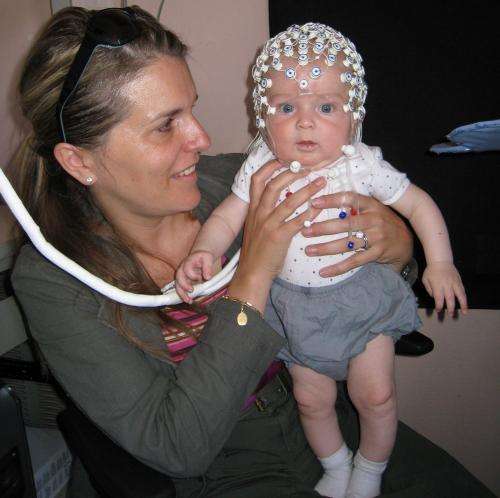April 19, 2013 report
Babies show visual consciousness at five months

(Medical Xpress)—A new study by scientists in France and Denmark has identified a neurological marker in the brain of babies as young as five months that is associated with visual consciousness, or the ability to process and remember images they have seen.
Research on adults has previously documented changes in the brain that are associated with visual consciousness, but demonstrating consciousness in young infants has proven difficult because they are unable to report on what they have seen. They have been observed to make behavioral responses to visual stimuli, but these behaviors (such as eye movements) are also observed in adults whose brains do not show the changes normally associated with visual consciousness.
The researchers, led by Dr Sid Kouider of the of École Normale Supérieure in Paris, tested the brain activity of 80 children 5, 12, and 15 months old in response to being shown pictures of human faces. Each infant was fitted with a cap covered with electrodes, and was then shown pictures for a range of times, starting with periods so short that adults would not be conscious of seeing them, and then gradually increasing the time the images were displayed. The display of each image (on a computer screen) was accompanied by a bell sound to attract the babies' attention.
In adults, the areas of the brain associated with vision are activated, even if the image is shown for such a short time that the subject is not consciously aware of it. When the image is displayed for at least 300 milliseconds (ms) a neural signal travels from the vision center at the back of the brain to the prefrontal cortex, and this is associated with the adult reporting being conscious of the image. This signal is known as the late slow wave, or nonlinear cortical response.
The visual cortex activity and late slow wave response were seen in all the children, but in the youngest infants the response was weak and only appeared if the image was displayed for 900 ms to over a second. In the oldest infants the response was more sustained and appeared with images displayed for about 750 ms.
The results of the research suggest the nonlinear cortical response may provide a marker for conscious thought, according to Dr Kouider, since the signal in the prefrontal cortex suggests the image is stored briefly in the brain's "working memory" or consciousness.
The findings could prove useful for testing individuals who are unable to report on what they are perceiving, such as people in comas. Similar methods may also be useful to help medical practitioners to better understand perception of pain or the effects of anesthetics on young children, and also help researchers studying consciousness in non-human animals.
The next steps in the research are to test two-month-old babies in the same way, and to test infants to see whether familiar objects such as favorite toys illicit a faster response.
More information: A Neural Marker of Perceptual Consciousness in Infants, Science 19 April 2013: Vol. 340 no. 6130 pp. 376-380 DOI: 10.1126/science.1232509
Abstract
Infants have a sophisticated behavioral and cognitive repertoire suggestive of a capacity for conscious reflection. Yet, demonstrating conscious access in infants remains challenging, mainly because they cannot report their thoughts. Here, to circumvent this problem, we studied whether an electrophysiological signature of consciousness found in adults, corresponding to a late nonlinear cortical response [~300 milliseconds (ms)] to brief pictures, already exists in infants. We recorded event-related potentials while 5-, 12-, and 15-month-old infants (N = 80) viewed masked faces at various levels of visibility. In all age groups, we found a late slow wave showing a nonlinear profile at the expected perceptual thresholds. However, this late component shifted from a weak and delayed response in 5-month-olds (starting around 900 ms) to a more sustained and faster response in older infants (around 750 ms). These results reveal that the brain mechanisms underlying the threshold for conscious perception are already present in infancy but undergo a slow acceleration during development.
© 2013 Medical Xpress
















